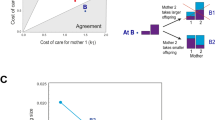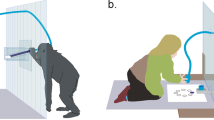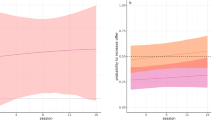Capuchins will voluntarily share treats with other monkeys that helped to secure them.
Abstract
Cooperative hunting, in which several individuals pursue prey but only one makes a capture, is central to theories of human social and moral evolution1,2,3. But among other primates, it is known only from the chimpanzee and a large-brained neotropical monkey, the capuchin4,5,6,7. It probably evolved through either mutualism, in which two or more cooperators benefit simultaneously, or reciprocal altruism, in which one favour is repaid by another8,9. We have found that brown capuchins (Cebus apella) share rewards obtained by a joint effort more readily than rewards obtained individually. Even if hunting in the field involves selfish opportunism, this food incentive will greatly enhance the persistence of cooperation.
Similar content being viewed by others
Main
We made a pair of monkeys work for food10, by placing two transparent bowls in full view. Each bowl was accessible to one monkey by pulling the tray towards itself using one of two protruding bars ( Fig. 1a). Individual strength was periodically tested to determine each individual's maximum pulling weight. We investigated three conditions: solo effort (only one monkey had access to a pull bar and a baited cup, and the tray was counterweighted within this individual's pulling capacity); cooperation (both monkeys had pull bars, and the tray was counterweighted such that the strength of both was required, but only one bowl was baited), and mutualism (same as co-operation, but with both bowls baited).
a, In a 144 × 60 × 60 cm test chamber, two monkeys were divided by a mesh partition. In cooperation tests, the strength of both monkeys was required to pull in a tray with two transparent bowls. In all 4 trials per test, apple slices were placed in the same bowl. In solo-effort controls, the bar in front of the empty cup was removed and the counterweight reduced. b, The rate of facilitated taking was higher after cooperation than after solo controls (ANOVA: F1,12 = 5.63, P = 0.018, directional). Also, the mean (± s. e.) percentage of food collections taking place within reach and sight of the possessor was 64.8 ± 4.5% after cooperation, compared with 57.9 ± 4.8% after solo controls (F1,12 = 10.44, P = 0.0035, directional). For further details see http://www.emory.edu/LIVING_LINKS/
We put eight apple slices into the bowl(s) at the start of each of four 10-min trials per test. After pre-training, we did a minimum of 24 cooperation, 8 mutualism and 8 solo-effort tests on each same-sex pair (5 female and 2 male pairs) of unrelated adults from the same social group, applying half the tests to each direction within a pair. The capuchins successfully pulled in the tray in a mean (± s. e.) of 85.4 ± 3.5% of solo-effort trials and 88.9 ± 2.7% of mutualism trials. The success rate for cooperation trials was substantially lower, 39.2 ± 3.1% (paired comparison with mutualism: t = 14.06, P < 0.001; with solo effort: t = 14.56, P < 0.001).
Capuchins will share attractive foods spontaneously, even if separated by a mesh restraint — a pattern known as “facilitated taking”, with the possessor approaching the divider and dropping crumbs or whole pieces while the partner reaches for the food11. As the possessor could monopolize the food by avoiding the divider, both parties play an active role. Facilitated taking is reciprocal across individuals as well as across time between any two individuals12.
We measured the amount of sharing as the number of times the partner's hand reached through the mesh to pick up food from the other side, limiting ourselves to unambiguous videotaped behaviour. We ignored mutualism tests, in which each individual had its own food. Compared with solo-effort tests, significantly more pieces of food were shared after successful cooperation trials. Moreover, a greater proportion of transfers after cooperation were of a tolerant nature (Fig. 1b).
Because the individual with the rewarding bowl was invariably motivated to pull, the helper's behaviour was decisive. We found that the helper pulled two to three times more often in cooperation trials if the preceding trial had been successful than if it had been a failure (analysis of variance: F1,11 = 12.41, P < 0.003, directional). This suggests either a stable motivation across trials or a causal connection between a share of the reward (9 out of 10 successful trials resulted in food transfer) and subsequent willingness to pull.
We have shown that capuchins cooperate even if it is obvious that only one of them, and which one, will be rewarded. The increase in sharing following cooperation may rest on psychological mechanisms as complex as mental score-keeping of services13 and “gratitude”8, or as simple as attitudinal reciprocity12. According to the latter explanation, a joint effort, and the mutual coordination this entails, may induce a positive attitude towards the partner, reflected in attraction and social tolerance. If this facilitates the sharing of pay-offs, in turn providing an incentive for continued cooperation, we have two mechanisms that together function as payment for labour and labour for payment.
References
de Waal, F. B. M. Good Natured (Harvard Univ. Press, Cambridge, MA, 1996 ).
Whiten, A. in The Descent of Mind (eds Corballis, M. C. & Lee, S. E. G.) 173–193 (Oxford Univ. Press, 1999).
Stanford, C. B. The Hunting Apes (Princeton Univ. Press, Princeton, NJ, 1999).
Goodall, J. in Primate Behavior (ed. DeVore, I.) 425–473 (Holt, New York, 1965).
Boesch, C. & Boesch, H. Am. J. Phys. Anthropol. 78, 547–573 (1989).
Perry, S. & Rose, L. Primates 35, 409–415 (1994).
Rose, L. Int. J. Primatol. 18, 727–765 (1997).
Trivers, R. L. Q. Rev. Biol. 46, 35–57 (1971).
Dugatkin, L. A. Cooperation Among Animals (Oxford Univ. Press, 1997 ).
Crawford, M. P. Comp. Psych. Monogr. 14, 1–88 (1937).
de Waal, F. B. M. J. Comp. Psychol. 111, 370–378 (1997).
de Waal, F. B. M. Anim. Behav. (in the press).
de Waal, F. B. M. Evol. Hum. Behav. 18, 375–386 (1997).
Author information
Authors and Affiliations
Corresponding author
Rights and permissions
About this article
Cite this article
de Waal, F., Berger, M. Payment for labour in monkeys. Nature 404, 563 (2000). https://doi.org/10.1038/35007138
Issue Date:
DOI: https://doi.org/10.1038/35007138
This article is cited by
-
The cognitive challenges of cooperation in human and nonhuman animals
Nature Reviews Psychology (2023)
-
A tale of two cities: emotion and reason in the formation of moral judgement and possible metaethical implications
History and Philosophy of the Life Sciences (2022)
-
Reciprocal allogrooming among unrelated Norway rats (Rattus norvegicus) is affected by previously received cooperative, affiliative and aggressive behaviours
Behavioral Ecology and Sociobiology (2017)
-
Indigenous Siberians solve collective action problems through sharing and traditional knowledge
Sustainability Science (2016)
-
Brazilian Undergraduate Students’ Conceptions on the Origins of Human Social Behavior: Implications for Teaching Evolution
Evolution: Education and Outreach (2015)
Comments
By submitting a comment you agree to abide by our Terms and Community Guidelines. If you find something abusive or that does not comply with our terms or guidelines please flag it as inappropriate.





